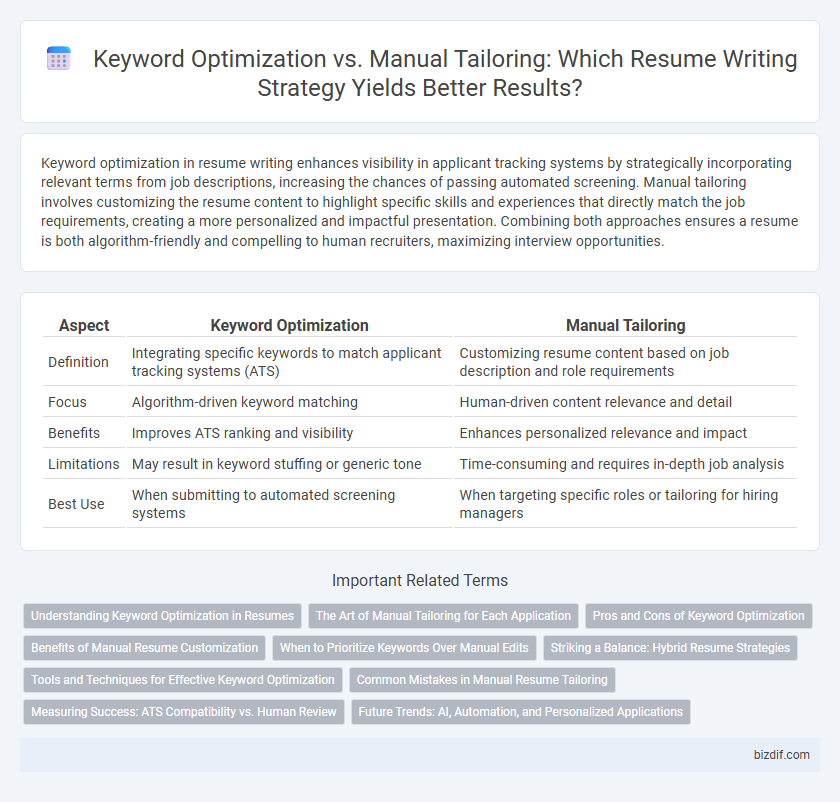Keyword optimization in resume writing enhances visibility in applicant tracking systems by strategically incorporating relevant terms from job descriptions, increasing the chances of passing automated screening. Manual tailoring involves customizing the resume content to highlight specific skills and experiences that directly match the job requirements, creating a more personalized and impactful presentation. Combining both approaches ensures a resume is both algorithm-friendly and compelling to human recruiters, maximizing interview opportunities.
Table of Comparison
| Aspect | Keyword Optimization | Manual Tailoring |
|---|---|---|
| Definition | Integrating specific keywords to match applicant tracking systems (ATS) | Customizing resume content based on job description and role requirements |
| Focus | Algorithm-driven keyword matching | Human-driven content relevance and detail |
| Benefits | Improves ATS ranking and visibility | Enhances personalized relevance and impact |
| Limitations | May result in keyword stuffing or generic tone | Time-consuming and requires in-depth job analysis |
| Best Use | When submitting to automated screening systems | When targeting specific roles or tailoring for hiring managers |
Understanding Keyword Optimization in Resumes
Keyword optimization in resumes involves strategically incorporating relevant terms and phrases from job descriptions to enhance visibility in Applicant Tracking Systems (ATS). This method improves the chances of passing automated screenings by aligning the resume's content with specific industry jargon and skills sought by employers. Manual tailoring complements this by customizing the resume for each application, ensuring a precise match between keywords and the job requirements.
The Art of Manual Tailoring for Each Application
Manual tailoring in resume writing enhances relevance by aligning specific skills and experiences with the job description, increasing the chances of passing Applicant Tracking Systems (ATS) and impressing hiring managers. Unlike keyword optimization, which relies primarily on inserting industry terms, manual tailoring involves customizing content to reflect unique qualifications and company culture. This approach ensures a more authentic and targeted presentation, maximizing the resume's impact for each application.
Pros and Cons of Keyword Optimization
Keyword optimization in resume writing enhances the chance of passing applicant tracking systems (ATS) by targeting specific industry-relevant terms and phrases. This method ensures higher visibility in automated screenings but may lead to a less personalized and generic tone if overused. Overemphasis on keywords can obscure key achievements and reduce the resume's appeal to human recruiters who value narrative clarity and individuality.
Benefits of Manual Resume Customization
Manual resume customization enhances relevance by aligning keywords precisely with the job description, improving applicant tracking system (ATS) compatibility. It allows incorporation of specific achievements and tailored language that highlight unique qualifications and experiences. This approach increases the likelihood of passing automated screenings and impresses recruiters with a personalized, role-specific narrative.
When to Prioritize Keywords Over Manual Edits
Prioritize keyword optimization when applying to large companies using applicant tracking systems (ATS) that scan for specific terms matching job descriptions. Focus on integrating relevant industry-specific keywords and action verbs to increase the chances of passing automated screenings. Reserve manual tailoring for smaller organizations or networking referrals where personalized content that highlights unique skills and experiences can make a stronger impact.
Striking a Balance: Hybrid Resume Strategies
Striking a balance between keyword optimization and manual tailoring in resume writing enhances both ATS compatibility and personalized appeal. Integrating targeted keywords ensures resumes pass automated screenings, while manual customization highlights unique skills and experiences for human recruiters. Employing a hybrid strategy maximizes job match relevance and improves overall interview chances.
Tools and Techniques for Effective Keyword Optimization
Effective keyword optimization in resume writing leverages advanced tools like Applicant Tracking System (ATS) scanners and semantic analysis software to identify and integrate industry-specific keywords that improve visibility to recruiters. Techniques such as job description parsing and keyword density analysis ensure that resumes align with automated screening algorithms, increasing the likelihood of passing initial filters. Manual tailoring complements this process by refining language nuances and context, but reliance on automated keyword optimization tools maximizes precision and efficiency in targeting relevant job roles.
Common Mistakes in Manual Resume Tailoring
Common mistakes in manual resume tailoring include overloading the document with keywords that disrupt natural phrasing and neglecting to prioritize the most relevant skills for the specific job description. Candidates often overlook integrating quantifiable achievements, reducing the impact of their experience despite customizing content. Failing to update action verbs and industry-specific terminology also weakens the resume's appeal to automated Applicant Tracking Systems (ATS) and hiring managers alike.
Measuring Success: ATS Compatibility vs. Human Review
Measuring success in resume writing involves balancing ATS compatibility with human review to maximize keyword optimization and manual tailoring effectiveness. ATS algorithms prioritize keyword density and relevance, ensuring resumes pass automated screening, while human reviewers focus on contextual clarity and personalization that resonate with hiring managers. Combining data-driven keyword strategies with nuanced manual adjustments enhances overall resume impact, improving both electronic filtering and recruiter engagement.
Future Trends: AI, Automation, and Personalized Applications
Keyword optimization in resume writing increasingly integrates AI-driven tools that analyze job descriptions to enhance relevance and improve applicant tracking system (ATS) compatibility. Automation streamlines the customization process by automatically suggesting tailored keywords based on industry trends and individual career profiles. Personalized applications leverage machine learning algorithms to create dynamic resumes that adapt to specific job requirements, boosting candidate visibility and engagement in competitive job markets.
Keyword Optimization vs Manual Tailoring Infographic

 bizdif.com
bizdif.com